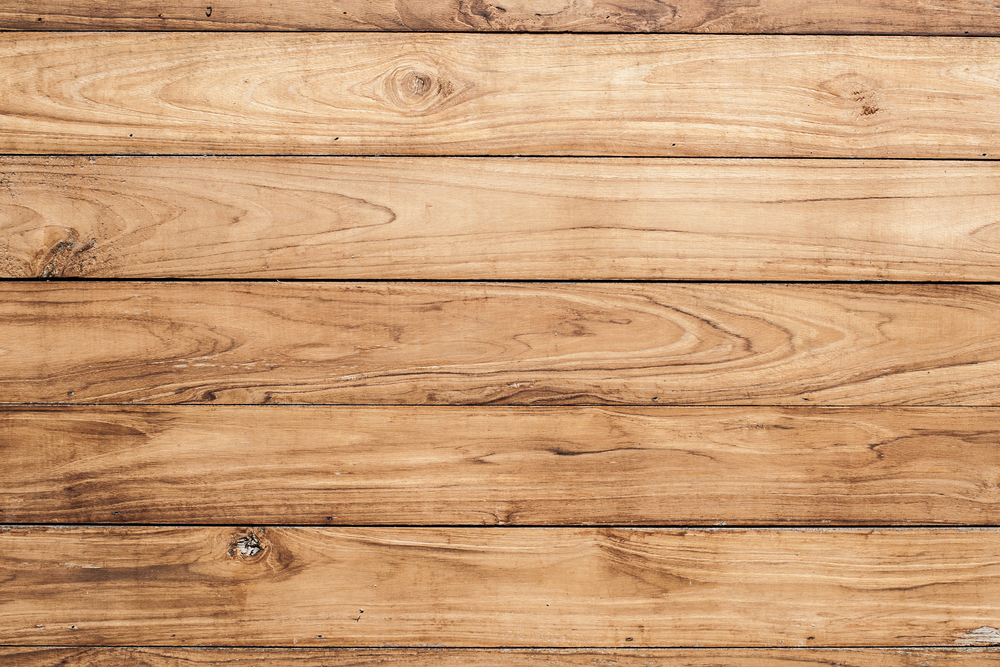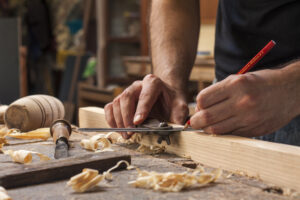
Wood grain is a crucial aspect to consider in carpentry and woodworking projects. It refers to the orientation and arrangement of the wood-cell fibres, which results in distinctive patterns known as figures. Grain types can be a blessing or a curse depending on the desired outcome. Straight grain is ideal for structural applications, while other grain types can produce exquisite figures. Different types of wood also have varying textures, including fine-grained and coarse-grained. Texture affects the size, arrangement of cells, and distribution of pores in the wood. Open-grained woods have larger pores, while closed-grained woods have smaller, less visible pores. Understanding wood grain is essential for choosing the right wood for different projects and achieving the desired finish.
Key Takeaways
- Wood grain refers to the orientation and arrangement of wood-cell fibres.
- Straight grain is ideal for structural applications.
- Different types of wood have varying textures, from fine-grained to coarse-grained.
- Open-grained woods have larger pores, while closed-grained woods have smaller, less visible pores.
- Understanding wood grain helps in choosing the right wood for different projects and achieving the desired finish.
Types of Wood Grain: Open-Grained and Close-Grained
When it comes to woodworking and carpentry, understanding the different types of wood grain is essential. Wood grain refers to the arrangement and orientation of the wood-cell fibers, which creates unique patterns and textures. In this section, we will explore two main categories of wood grain: open-grained and close-grained.
Open-Grained Woods
Open-grained woods, such as oak and ash, have larger visible pores that give them a distinct appearance. These visible pores contribute to pronounced grain patterns, enhancing the natural and rustic look of the wood. The open grain also adds texture and depth to the finished piece. Oak, with its prominent grain patterns and rich hues, is a popular choice for furniture and cabinetry. Ash, known for its light colour and flexibility, is often used in flooring and woodworking projects.
Close-Grained Woods
Close-grained woods, like cherry and maple, have smaller and less noticeable pores compared to open-grained woods. The close grain results in a more uniform and consistent pattern, making these woods ideal for achieving a sleek and polished finish. Cherry wood, with its warm tones and smooth texture, is commonly used in high-end furniture and cabinetry. Maple, known for its light colour and durability, is prized for its fine grain and versatility in various woodworking applications.
Choosing between open-grained and close-grained woods depends on the desired aesthetic and texture of the final product. Open-grained woods offer unique grain patterns and a rustic feel, while close-grained woods provide a more refined and polished appearance.
| Wood Type | Grain Pattern | Common Uses |
|---|---|---|
| Oak | Open-grained | Furniture, flooring, cabinetry |
| Ash | Open-grained | Doors, millwork, woodworking projects |
| Cherry | Close-grained | Furniture, cabinetry, musical instruments |
| Maple | Close-grained | Flooring, cutting boards, decorative veneers |
| Walnut | Open-grained | Furniture, gunstocks, crafts |
Understanding the different types of wood grain allows woodworkers and carpenters to choose the right wood for their projects. Whether aiming for a rustic or polished finish, the choice between open-grained and close-grained woods contributes to the overall beauty and character of the final piece.
Different Grain Descriptions and Patterns
Wood enthusiasts and designers often use specific labels to describe different grain patterns. When examining wood grain, several distinct patterns can be identified.
Straight Grain
Straight grain is characterized by fibres that consistently run in a straight direction along the cut wood. This pattern is commonly found in many types of wood and is ideal for creating structural elements in carpentry and woodworking projects.
Spiral Grain
Spiral grain occurs when the fibres twist as the tree develops. This pattern gives wood a unique and visually intriguing appearance. While spiral grain may add visual interest, it can also present challenges when working with the wood due to its tendency to split.
Interlocked Grain
Interlocked grain describes fibres that align in opposite directions, creating a distinctive pattern. This grain pattern can make working with the wood more difficult, as it can be prone to tearout and splitting. However, interlocked grain also adds character and depth to the finished product.
Irregular Grain
Irregular grain involves fibres running in irregular and varying directions, often seen around knots in wood. This unique pattern can add visual interest to woodworking projects and showcase the natural beauty of the wood.
Wavy Grain
Wavy grain refers to fibres that change direction constantly, creating a wave-like pattern. This grain pattern can give wood a sense of movement and can be particularly eye-catching when used in furniture and decorative pieces.
Figured Woods
Highly-figured woods, such as bird’s eye, burl, and flame maple, offer unique and sought-after patterns that add a special touch to woodworking projects. These woods display intricate and mesmerizing natural designs that make them prized among craftsmen.
Understanding these different grain descriptions and patterns allows woodworkers to choose the right wood for their projects and take advantage of the distinctive characteristics offered by each type of grain.
Wood Grain and Workability

In carpentry, understanding the relationship between wood grain and workability is crucial. Grain orientation has a significant impact on how easy or difficult it is to work with different types of wood.
Timbers with a straight grain pattern are generally more workable and provide consistent results. The fibres run parallel to each other, making it easier to cut, shape, and join the wood. This makes straight-grained woods the preferred choice for many structural applications.
On the other hand, woods with interlocked or irregular grain can be more challenging to work with. These grains occur when the fibres twist or change direction, causing the wood to split, tear, or exhibit tearout during machining. When handling interlocked or irregular grain, it’s crucial to work with the grain to minimize these issues and achieve the desired results.
The grain pattern also affects the finishing process of wood. Open-grained woods, which have larger visible pores, tend to absorb finishes unevenly. This can result in a less uniform appearance. In contrast, closed-grained woods with smaller pores offer a smoother and more consistent finish. Carpenters and woodworkers need to consider the grain characteristics of the wood they’re working with to determine the best finishing techniques.
By understanding how wood grain influences workability, carpenters and woodworkers can choose the right approach for each project. Whether it’s selecting the appropriate wood species, using the correct cutting techniques, or applying the right finishing method, considering the grain orientation is essential for achieving the desired outcome.
Achieving Different Textures with Wood Grain
The texture of wood grain is an important consideration when working with wood. It is determined by the size, variation, and arrangement of wood cells, which contribute to the overall appearance and feel of the wood. Understanding the different types of grain textures can help you choose the right wood for your project and achieve the desired finish.
Fine-Grained Wood
Fine-grained woods have a more uniform and consistent cell structure, resulting in a smoother texture. These woods are often sought after for their refined appearance and luxurious feel. Examples of fine-grained woods include mahogany, cherry, and maple.
Coarse-Grained Wood
On the other hand, coarse-grained woods have a more varied composition and a rougher texture. The larger size and irregular arrangement of wood cells give these woods a distinct character. Oak, ash, and walnut are examples of coarse-grained woods that offer a unique and rustic appeal.
- Fine-grained woods have a smoother texture
- Coarse-grained woods have a rougher texture
The choice between fine-grained and coarse-grained wood depends on the desired aesthetic and the overall style of your project. If you are aiming for a polished and sleek finish, fine-grained wood is the way to go. On the other hand, if you prefer a more natural and textured look, coarse-grained wood can add depth and character to your work.
Texture and Wood Finish
Texture also plays a significant role in determining the final appearance of a wood finish. Open-grained woods, such as oak and mahogany, with their larger visible pores, tend to have a coarser texture. This can affect how stains and finishes are absorbed by the wood. Close-grained woods, like maple and cherry, have smaller, less visible pores, resulting in a smoother texture and a more even application of finishes.
When selecting wood for your project, consider both the texture of the wood grain and the desired finish. Experimenting with different wood types and finishes can lead to unique and personalized results.
| Fine-Grained Wood | Coarse-Grained Wood |
|---|---|
| Smooth texture | Rough texture |
| More uniform and consistent cell structure | Varied composition and irregular cell arrangement |
| Generally lighter in weight | Often heavier and denser |

Conclusion
Wood grain is an essential element in the world of carpentry and woodworking. It plays a significant role in shaping the beauty and durability of wooden creations. By understanding the various grain patterns, textures, and workability of different types of wood, carpenters and woodworkers can make informed decisions when selecting materials for their projects.
Open-grained and close-grained woods offer distinct aesthetic qualities. The direction of the grain also affects the workability of the wood and the finishing process. These factors must be carefully considered to achieve the desired outcome in carpentry and woodworking.
Whether it’s choosing a particular timber for a furniture piece or selecting the right wood for a structural project, considering wood grain and its characteristics is crucial. By harnessing the unique qualities of wood grain, professionals in the industry can create stunning and functional wooden furniture, structures, and more.
FAQ
What is wood grain?
Wood grain refers to the orientation and arrangement of wood-cell fibers, which create distinct patterns known as figures.
How is wood grain categorized?
Wood grain can be categorized into open-grained and close-grained. Open-grained woods have larger visible pores, while close-grained woods have smaller, less noticeable pores.
What are some examples of open-grained woods?
Examples of open-grained woods include oak and ash, which have pronounced grain patterns and are ideal for achieving a natural or rustic look.
What are some examples of close-grained woods?
Examples of close-grained woods include cherry and maple, which have a more uniform grain pattern and are suitable for creating a sleek and polished finish.
What are the different grain patterns in wood?
The different grain patterns in wood include straight grain, spiral grain, interlocked grain, irregular grain, and wavy grain. Highly-figured woods such as bird’s eye, burl, and flame maple also offer unique patterns.
How does wood grain affect workability?
Timbers with straight grain are easier to work with, while woods with interlocked or irregular grain can be more prone to splitting and tearing during machining.
How does wood grain affect finishing?
Open-grained woods show a more uneven takeup of finishes compared to close-grained woods. Grain direction and texture also impact the finishing process.
How does wood grain influence texture?
The texture of wood grain is determined by the size, variation, and arrangement of wood cells. Fine-grained woods have a smoother texture, while coarse-grained woods have a rougher texture.
Why is understanding wood grain important in carpentry and woodworking?
Understanding wood grain helps carpenters and woodworkers choose the right wood for their projects, achieve the desired finish, and work with the grain for optimal results.
- Drill Battery Maintenance: Essential Tips for Cordless Drill Battery Care - February 5, 2024
- Troubleshooting Drill Issues - February 5, 2024
- Quick Drilling Techniques - February 2, 2024










